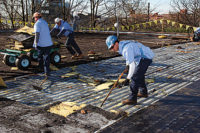Installing energy-efficient roofs is a trend that does not appear to be going away. That trend, coupled with easy access to information, is changing the roofing landscape. Building owners and homeowners are becoming more data savvy and not only want a building that is built to save them money, but potentially earn them money. Thanks to Internet search engines, there are many online resources to gather enough information to know that there are ways to make any renovation and new construction project an earning opportunity. As contractors are bidding on projects, it is important to find ways to separate their business from the others. Staying informed about changes to consumers’ needs is paramount to continued success. Detailing the ways the roof products and systems utilized can save the building owner or homeowner money and including that information with the submittal is a great way to stand apart. But where do you get the information? What resources are reliable and accurate? How much time will it add to the submittal proposal process? Here are some resources to help you in gathering the necessary intelligence.
The U.S. Department of Energy (DOE) has a website (www.dsire.org) that features a database of state incentives for renewables and efficiency. There are tools such as a summary table that lists the tax incentives, rebates, grants and loans available statewide and locally. There are more than 1,100 rebates listed as available through utility companies, local governing bodies and state governments. Also listed on the site is a summary of the rules and regulations associated with tax deductions and rebate eligibility.
The DOE also has a website dedicated to the State and Local Energy Efficiency Action Network (SEE Action), a state- and local-led effort facilitated by the U.S. Department of Energy and the U.S. Environmental Protection Agency to take energy efficiency to scale and achieve all cost-effective energy efficiency by 2020. The site links to working groups that address building energy codes; residential retrofit; evaluation, measurement and verification; and others. The website is www1.eere.energy.gov/seeaction.
The Federal tax deduction for energy-efficient retrofits of commercial and multi-family buildings expired in 2013. While there was a bill introduced in the Senate in 2012 for an extension, the bill has yet to be passed. The bill proposed would extend the Section 179D tax deduction through 2016, while modifying the deduction to target the retrofits of existing commercial buildings. Section 179D was established by the Energy Policy Act of 2005 and allows a deduction of up to $1.80 per square foot for new buildings or renovations designed to use 50 percent less energy than ASHRAE Standard 90.1-2001.
While the number of local and state tax deduction opportunities is limited, there is the potential for these governing bodies to offer more local tax incentives for using energy-efficient materials as federal funds dry up. In the interim, there are a number of utility companies that offer rebates for using energy-efficient roofing materials, and that number continues to grow. Available to both commercial and residential projects, utility company rebates are available in many regions. Each utility company has its own set of rules to be eligible for the rebates, and the variances are vast. Be sure to contact the utility company before you begin any project where the building owner is expecting a rebate. Contractors may need to be qualified as an eligible contractor by the utility company.
Here are a few examples:
- Florida Power & Light (FPL) requires contractors to be approved as a Participating Independent Contractor (PIC). While a contractor is listed on the website as a business that has agreed to comply with FPL’s Program Standards, FPL does not officially recommend the PIC. Through FPL’s program, work must be completed by a PIC; there is a pre-qualification conducted by FPL before the job starts; the exiting roof solar reflectance must be less than 40 percent; and there must be a 10-year manufacturer’s full system warranty for the white roof surfaced materials installed, which must have a solar reflectance of 73 percent or greater. FPL’s program is for commercial and residential buildings.
- Austin Energy’s Power Saver Program is for commercial projects only. This program does not require contractors to be pre-qualified, but the jobsite must be pre-verified by Austin Energy before the new roofing materials are installed to determine existing R-value and that the existing roof is not reflective. This program specifically calls out that the roof material is a reflective roof coating requiring ASTM test data be submitted verifying 75 percent reflectivity.
- Pacific Gas & Electric Company (PG&E) offers a comprehensive rebate program to its customers in both residential and multi-family properties. This program does not require an approved contractor, nor does it require a pre-installation jobsite inspection. Rebates require the projects meet certain criteria including the installation address being in qualifying climate zones and installed products being listed with the Cool Roof Rating Council (CRRC). The building must have central air conditioning, and a new A/C system must be installed concurrently. Proof of purchase is also required.
Each utility company has its own rules and its own ways of governing those rules. It’s important to understand the rules in an effort to assist your customers in navigating the sometimes confusing process. Reach out to your respective companies to become informed on their programs. The bottom line is that your customers have access to this information and so should you.
Take advantage of the many tools and resources available through your local utility companies and government bodies. Partnering with your customer in providing them the most energy-efficient roof system and the financial incentive to choose that system will ultimately help your customer and your business. Stand apart from the competition by providing solutions to your customers. The result could be happy customers, referrals and energy-efficient buildings that are better for the environment — a win for everyone.




.jpg?height=200&t=1633139734&width=200)

